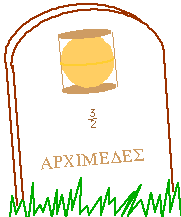Archimedes is considered to be one of the greatest mathematicians and
scientists.
In 212 BC, Romans stormed the city of Syracuse.
Seventy-five year old
Archimedes was so focused on his mathematical work that he ignored and hence
enraged a soldier. The soldier then killed him.
According to Plutarch (AD 45-120), Parallel Lives: Marcellus,
Archimedes
had requested that a pictorial representation of a sphere and
a cylinder appear on his tombstone.
From this, we can infer that
he must have considered his work on a sphere and a cylinder to be one
of his greatest accomplishments.
Cicero (106-43 BC), in Tusculan Disputations, Book V, Sections 64-66,
states that he went to Syracuse and indeed found the grave which
contained the pictorial representation along with text verses.
The formulas for the volume and
surface area of a cylinder were known before Archimedes' time,
but those for a sphere were not known. Archimedes wanted to find
exact expressions for the volume and surface area of a sphere, and he
did indeed do just this by using ideas related to Cavalieri's Principle.
|
 |
